This is the third in a five-part series on the historic home courts of the Indiana University basketball program. Today we take a look at the third home of the Hoosiers — the Old Fieldhouse.
A New Shrine Symbolizing a Growing Statewide Hysteria…
By the mid-1920’s, basketball in Indiana had grown from a new sport to a statewide obsession in just over 30 years. Similarly, the Indiana University men’s basketball program had become nationally significant, and in many ways the epicenter of the game in the Hoosier state.
The growth of the game and the IU program meant that the Men’s Gymnasium, which was just built in 1917, soon became inadequate. Under the direction of head coach Everett Dean, IU had experienced 12 straight seasons at .500 or better, and the Hoosiers won Big Ten titles in 1926 and 1928. The 2,500 seat Men’s Gymnasium could no longer meet the growing demand for tickets.
It was time to move to a facility worthy of an emerging college basketball giant. Behind the leadership of Athletic Director Zora Clevenger and President William Lowe Bryan, plans were finalized to significantly upgrade IU’s athletic facilities in 1928.
According to Indiana University Archives, construction began on the new facility on February 24, 1928. To ensure that it fit in with the iconic campus theme, the Bloomington Limestone Company supplied 13,000 cubic feet of Ashtone limestone. The mammoth structure also required 670 tons of steel.
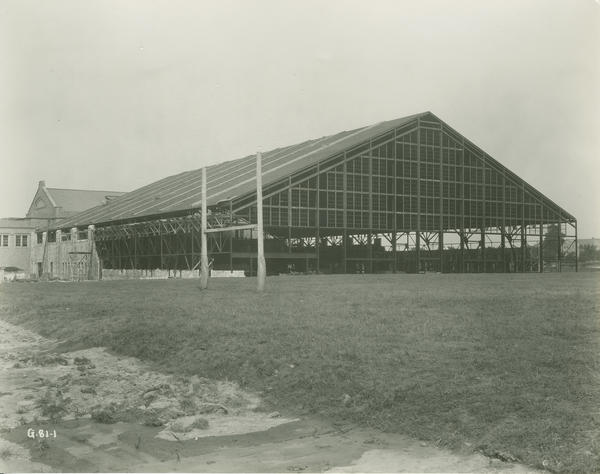
The cost of construction was between $300,000 and $350,000. That translates to around $5 million in today’s dollars.
Amazingly, the new facility was ready in just over nine months. This was possible in large part because the structure was primarily just a shell with dirt floors and no permanent seating. The portable basketball court and seating was installed only for the basketball season. One of the first uses for the new structure, if not the first use, was a practice facility for the football team.
The November 29, 1928 Indianapolis Star described how the Fieldhouse symbolized what the sport of basketball had become in the state of Indiana at the time:
“Indiana University’s new fieldhouse, stretched like a giant train shed from the east side of the men’s gymnasium stands today as a huge symbol in stone and steel of the amazing growth of basketball into the outstanding sport here.”
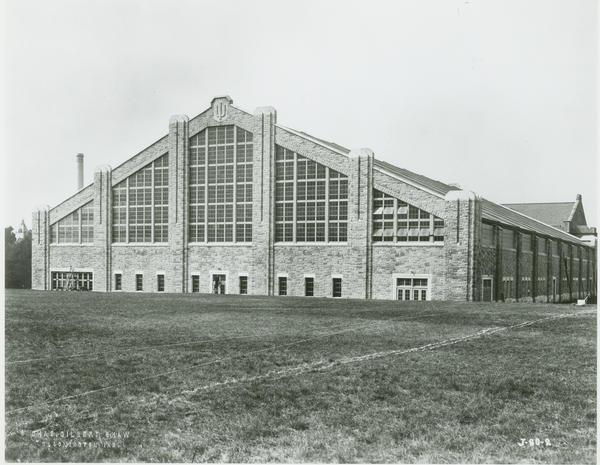
With 47 electric lamps suspended from the ceiling and seven floodlights, the new arena was ready for primetime. The first basketball game played at the Old Fieldhouse was on December 8, 1928 vs. Washington of Missouri. The seating capacity of the Old Fieldhouse was around 8,000 for that game. Later modifications would expand the seating capacity to around 10,000.
Things got off to an inauspicious start as IU lost the inaugural game 31-30. Junior center and future head coach Branch McCracken scored the first ever points at The Old Fieldhouse in this game.
The Old Fieldhouse was formally dedicated less than a week later on December 13, 1928 with a basketball game vs. Pennsylvania which IU won 34-26. The Hoosiers would go on to suffer their first losing season since 1916, but things would get better.
The facility would go on to have a number of non-basketball uses. Some came to know it as the place to register for classes, the location for commencement, and a practice facility for the tennis and track teams, to name a few.
The facility was also used by teams not affiliated with the school, such as the Cincinnati Reds and the Indianapolis Indians. It was reportedly during one of these visits to Bloomington that the Reds discovered IU slugger Ted Kluszewski.
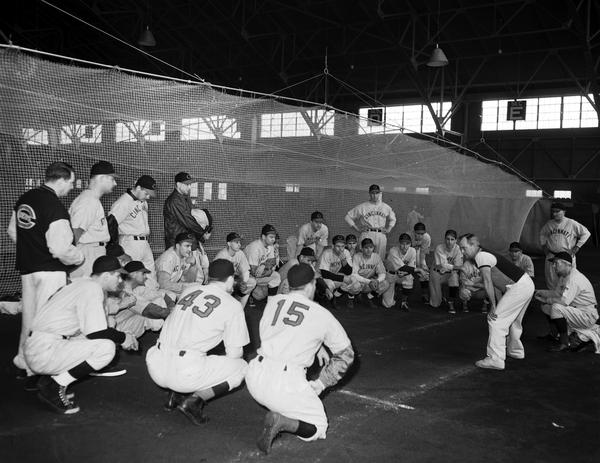
After some choppy early years at The Old Fieldhouse, Dean got the program headed back in the right direction. A 1936 Big Ten title set the stage for several strong seasons that culminated in a 24 game home court winning streak and the program’s first national title in 1940.
Despite not winning the Big Ten in 1940, Indiana was selected by the NCAA committee over conference champion Purdue. IU had swept Purdue that season and finished in 2nd place. On the final game of the season, IU dominated Ohio State 52-31 at the Old Fieldhouse. That victory likely ensured that IU received the NCAA tournament invite, as it secured 2nd place outright, putting the Hoosiers a game above the Buckeyes.
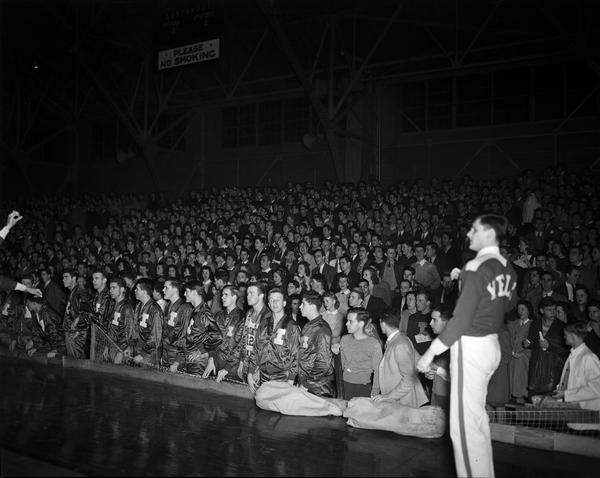
The Old Fieldhouse saw more than just the successful advancement of a basketball program. Much more in fact. Two significant events in the history of the advancement of African-Americans in college athletics occurred at the former IU home court.
Shelbyville, Indiana native Bill Garrett became the first African-American to play for IU on December 4, 1948 at the Old Fieldhouse. Later that same year the sophomore again broke a color barrier as he became the first African-American to play in a Big Ten basketball game on January 8, 1949 — before a packed house of 10,013 at the Old Fieldhouse.
Within a year of Garrett’s graduation from IU, six other African Americans were on Big Ten basketball rosters.
Fifty years into the history of the IU basketball program, a possible college basketball first — and something we take for granted today — would occur at the Old Fieldhouse.
On December 6, 1951, some believe the first live televised regular season college basketball game was produced as IU played Valparaiso. IU won the game 68-59.
It is possible that earlier regular season games were televised. Reportedly two regular season games at Madison Square Garden in New York were televised live. Interestingly, those games occurred 11 years earlier in 1940.
There is a plaque commemorating the event on the west end of the Fieldhouse.
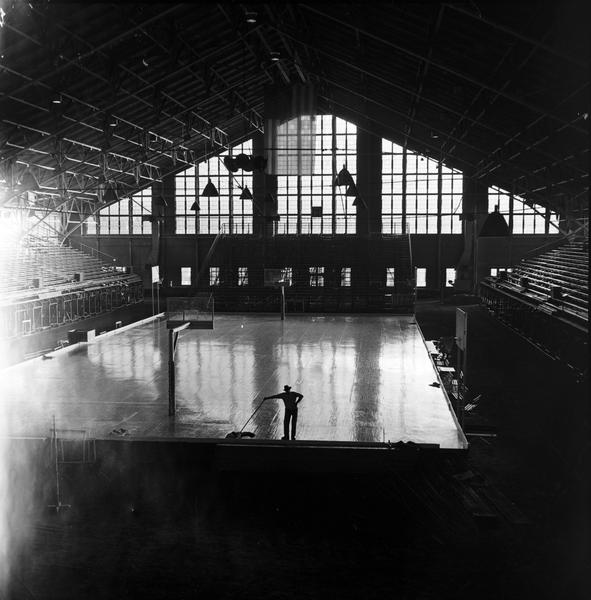
IU continued to have strong seasons through the 1940’s, but the arrival of a 6-foot-9 center from South Bend would change the trajectory of the program. Don Schlundt and all NCAA freshmen were allowed to play in the 1951-52 season due to the Korean War. That season of experience for Schlundt, playing alongside a strong sophomore class that included Bobby Leonard and Dick Farley would set the team up for greatness the following season.
The Hoosiers were a perfect 12-0 at the Old Fieldhouse for the 1952-53 season. McCracken’s “Hurryin’ Hoosiers” broke the 100 point mark twice at home that season, both times resulting in 35-point wins over in-state rivals Butler and Purdue.
The legendary 1953 season culminated back at the Old Fieldhouse. After a 69-68 national title game victory over Kansas, the Hoosiers headed home. According to the Bloomington Daily Herald-Telephone, “a parade started at 10th and Walnut Streets and moved to the Square and then on to the Fieldhouse.”
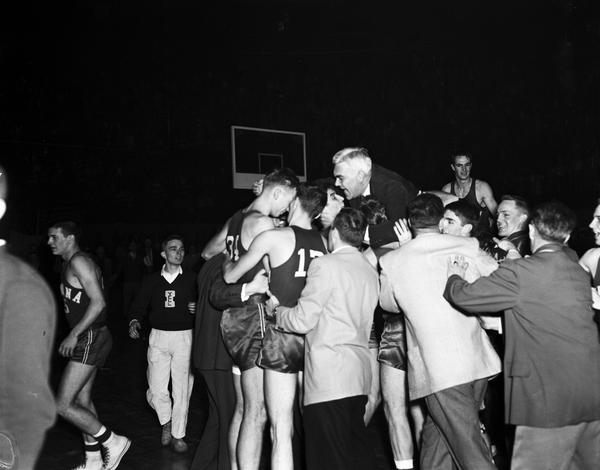
Indiana would close out the Old Fieldhouse era in legendary fashion. The 1960 Ohio State Buckeyes are widely regarded as one of the better teams in the game’s history. Led by Hall of Famers Jerry Lucas and John Havlicek, the Buckeyes came to Bloomington on February 29, 1960 with a perfect 13-0 conference record.
Indiana was strong that season as well. Led by another Hall of Famer in Walt Bellamy, IU finished the season at 20-4.
The Hoosiers came out strong and never looked back in the final game at the Old Fieldhouse, winning by a score of 99-83. For all of the legends on the floor that day, the most noteworthy player might have been an Ohio State reserve — Bob Knight.

The Hoosiers would complete six perfect seasons on their home court at the Old Fieldhouse and compile an overall record of 234-74. The Old Fieldhouse era would see IU win two national titles and five Big Ten titles. 20 IU All-Americans called the Old Fieldhouse home, along with three Big Ten most valuable players.
With IU enrollment growing and campus space limited, a difficult decision was made to move out of the Old Fieldhouse as part of the continuing move of all of IU’s athletic facilities just north of 17th Street. Memorial Stadium opened for the football team in 1960, and basketball would soon follow at the “New Fieldhouse” (now known as the Gladstein Fieldhouse) months later.
The Old Fieldhouse was renamed the Ora L. Wildermuth Intramural Center on April 25, 1970.
Today it is known by a several different names. Some still call it the Old Fieldhouse, while other refer to it as the Wildermuth Center, or the “HYPER”.
Whatever you call it, one thing is certain. This is the place where IU basketball became a national powerhouse. You can still go there today, basketball in hand, and relive the glory.

You can follow us on Twitter: @daily_hoosier
Find us on Facebook: thedailyhoosier




